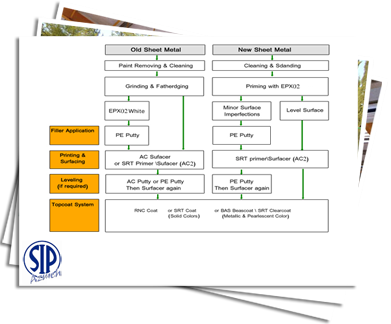Car Coatings Systems
Automotive Refinishes – SUBSTRATE TREATMENT

Substrate Treatment In The Repair Area
|
A- PAINT REMOVING &
CLEANING
-
Paint Removing:
Remove flecks of
old paint with a scraper, sandpaper, or SIP Paint Remover.
-
Detergent Wash:
Remove dirt and
water soluble contaminants by washing with detergent and hot
water solution. Rinse well and wipe surface thoroughly with a
clean dry cloth.
-
Solvent Clean
Remove grease,
oil, and other contaminants with thinner S100 or S501, then wipe
surface thoroughly with a clean dry cloth.
|
|
B-
GRINDING AND FEATHEREDGING
Grind and feather
the edge of the old paint using 80 grit treated sandpaper.
|
|
C-
FILLER APPLICATION
-
Fill imperfections of damaged
area using PE Putty.
-
Shape filler using firm pressure
to bond well the filler to the substrate and to prevent
entrapment of air bubbles inside the putty.
-
It is recommended to apply filler
in thin coats (< 2 mm) with a total thickness not exceeding 6mm.
-
Allow filler to dry then sand
repaired area using 180, 240 then finish sanding using 320-400
grit treated sandpaper.
-
Remove sanding
residue using air pressure, then clean by thinner S100 or S501.
Note:
For maximum corrosion protection it is recommended to apply a
thin coat of epoxy primer EPX02 “White” to bare substrate before
filling.
|
|
D-
PRIMING & SURFACING
-
Apply 2-3 medium coats of
SRT primer / Surfacer (AC2)
and allow each coat 5-10 minutes to flash until hand slick. “If
needed, for extra flow, an additional amount of thinner S507
(25%) may be added to the primer/surfacer”.
-
Sand
SRT primer / Surfacer (AC2) with 180-240 grit treated
sandpaper. Then finish sanding with 320-400 grit treated
sandpaper.
-
Remove sanding residue using air pressure, then clean by thinner
S100 or S501.
Notes:
- Before sanding, a special attention should be
taken toward dry to sand condition.
- If needed, for best leveling, apply PE
putty or AC putty then surfacer again.
|
|
E-COATING
" One Component Coating (RNC coat) "
-
Use conventional sprays gun and adjust air pressure to obtain
the best atomization.
-
Apply several coats of RNC coat to obtain opacity and allow each
coat 5-10 minutes to flash until hand slick.
-
Sand with 1000-2000 grit treated sandpaper to remove dust.
-
Polish with fine or
medium polishing compound for leveling, then finish polishing
with ultra fine polishing compound for obtaining gloss.
|
|
E-COATING
Two-Component Coating (SRT
Coat)
-
Use conventional sprays gun and adjust air pressure to obtain
the best atomization.
-
Apply several coats of
SRT Coat to obtain opacity and allow each coat 5-10 minutes
to flash.
-
Allow
SRT Coat to cure according to its curing cycle “drying
time”.
Notes:
- Polishing, in general, is not required.
- Use the appropriate thinner according to weather condition and
curing method.
|
|
E-COATING
Basecoat / Clearcoat System
-
Use conventional sprays gun and adjust air pressure to obtain
the best atomization.
-
Apply several coats of
BAS Basecoat to obtain opacity and allow each coat 5-10
minutes to flash until hand slick.
After hiding is achieved, it is recommended to apply a
low-pressure mist coat in order to prevent marks formation of
metallic particles in the paint film.
-
Allow
BAS Basecoat 30 minutes to flash before applying clearcoat.
-
Apply 2 coats of
SRT clearcoat immediately on dry
BAS Basecoat and allow the first coat 10-20 minutes to
initial dry before applying the second coat.
Note:
Polishing is not required.
|
|